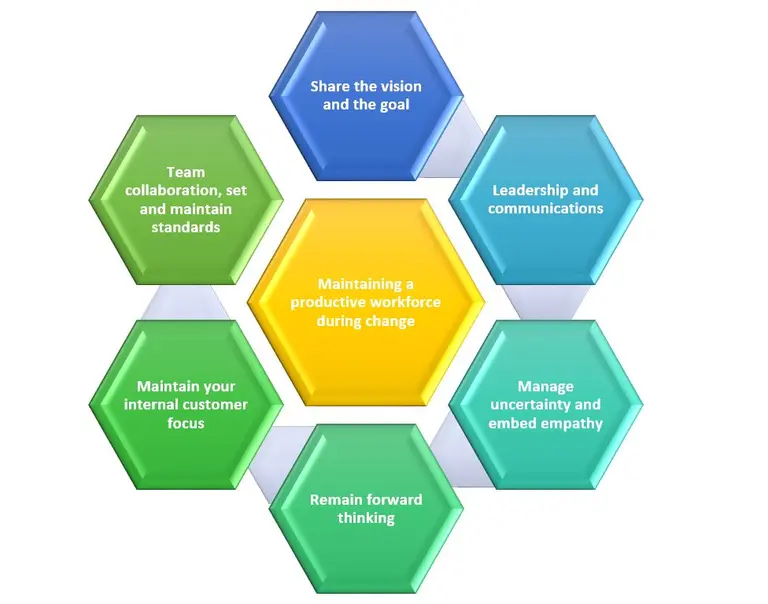Managing and maintaining a productive workforce is especially critical in times of change. Whether you’re going through a strategic change programme, restructuring roles and responsibilities or are evaluating skills required to drive your business forward, the need to operate effectively, maintain a productive workforce and reduce impacts to bottom line remains key for most organisations.

Share the vision and goal
Establishing a shared vision is key as it co-ordinates the actions of individuals towards agreed goals. Ensure your vision is communicated and understood, focused and actively supported by your change leaders.
Inclusive leadership
Successful leaders share responsibilities which enable others to proactively own and address change. This encourages the sharing of issues and concerns with the wider group and maintains an open forum of communication and dialogue.
Communicate effectively and regularly
Regular and effective communication without a doubt is a crucial aspect of change management. Without effective communication, you will have difficulty in achieving goals and may even jeopardise the success of your change project.
Implications for the Future
Having an accurate understanding of the future implications and expectations is perhaps the most crucial key to maintaining a productive workforce during times of change. Where expectations of what the work will be like are not accurate, it usually leads to uncertainty, doubt and potential dis-engagement of your workforce.
Acknowledge uncertainty
If you sense your workforce are concerned about the future of your organisation or their job security, don’t ignore this and hope it will disappear. Recognise and acknowledge how individuals are feeling with empathy so they air their concerns.
Embed shared empathy
Encourage all to have shared empathy and help your workforce to recognise they are not on their own.
Forward thinking
Employees need to be confident in the company they work for. If there are no communications from the business surrounding a change project your workforce may start to question the integrity of their leaders.
The level of motivation that your workforce has comes as a result of a number of factors, many of which you have the power to control, or at the very least influence. Be sure you are making conscious efforts to keep your employees engaged and motivated in their roles. A happy and well looked after workforce is more productive.
High performing teams pay attention to their internal customers (your workforce) and focus on their requirements, satisfaction, and complaints. By using employee satisfaction surveys and performance goals, you can focus on issues before they become problems, gauge how your workforce is dealing with the change and encourage your teams to continuously improve performance.
Ask your workforce what they need
Talk with employees on a one-on-one basis and let them verbalise what they are going through. Do some “perspective-taking by putting yourself in their shoes,” so you understand what they think and feel. These empathy based conversations form the basis of trust so that you can move into problem-solving mode. What help, support and/or guidance do they need? How can they enhance their concentration? Better prioritise their work during the change?
Gather feedback and data
Successful teams meet often to review current performance, develop improvement plans using clear performance measures and identify ‘blockers.’ As part of your change management project, frequently analyse the information and develop the action plan to address issues.
Encourage wider teamwork
Encouraging your workforce to build strong working relationships and work collaboratively is a key factor in fostering employee engagement and can help overcome resistance to change. Working as part of a group inspires innovation, sparks debate, and ultimately produces more creative results. In return it also increases output and quality of work.
Focus on what you can control – set and maintain the standards
Employees should be familiar with what the company expects from them. They need to know what they should be doing as well as their assigned roles. Without clear or explicit expectations, people tend to find excuses when they fail to achieve targets and may use ‘the change’ as a reason. It’s therefore key to be clear at the outset of the change project:
a) defining what you expect of everyone
b) how you expect people to perform their assigned tasks and responsibilities
Your workforce will be more motivated if they know what they are expected to achieve. Clearly stating goals or having a company vision provides guidance for everyone. Short-term goals, in particular, are effective in encouraging employees to properly manage their speed in doing tasks to meet targets. Additionally, it is important to provide feedback and achievements should be acknowledged, whilst errors or failures in meeting targets should be promptly addressed. Good management practices are never more vital than in times of change as they help maintain employee productivity.
In Summary
Maintaining and enhancing a productive workforce in times of change is not always simple to achieve but it can summarised in some simple concepts:
- the need for employee motivation and engagement
- the proactive involvement of visible management
- free-flowing communication process which actively listens to and addresses/resolves concerns and issues.
Want to know more?
Join us on our free webinar - How to thrive in times of change this September.
We’ll provide tips from our HR consultancy and legal experts on managing change in the workplace, providing advice to help you understand key drivers for change in 2019, what factors to consider for change, how to prepare for change and what it involves, the pitfalls and how to keep your employees engaged throughout a change programme.
